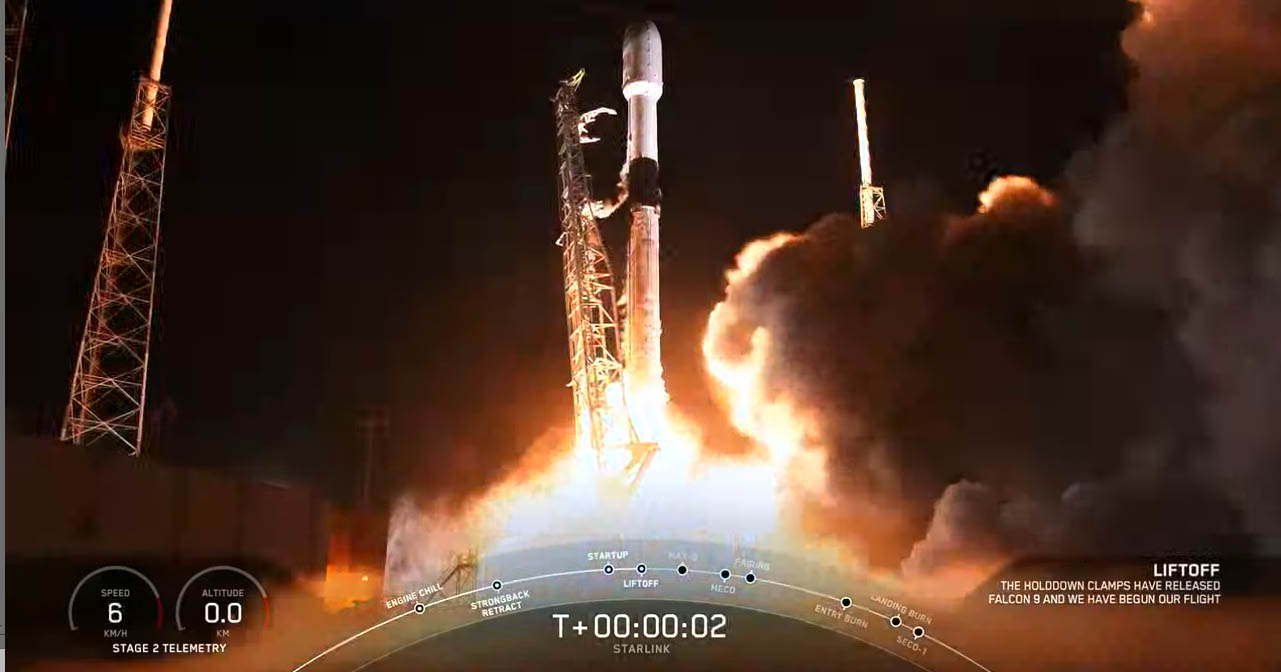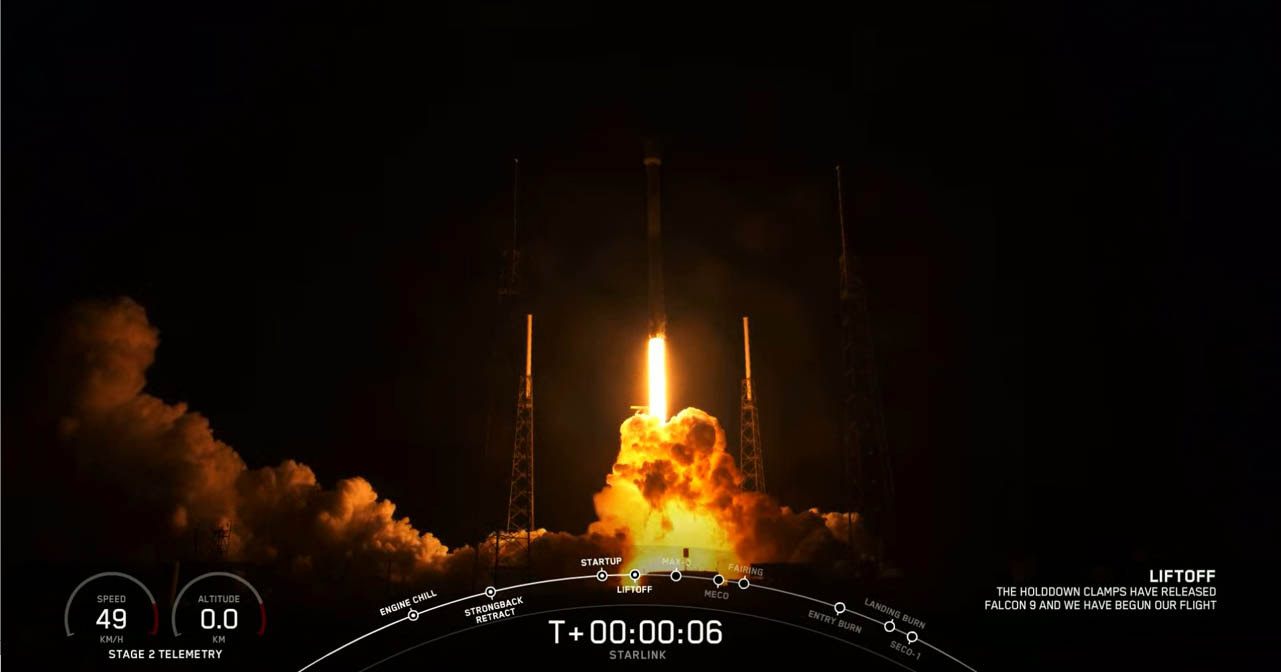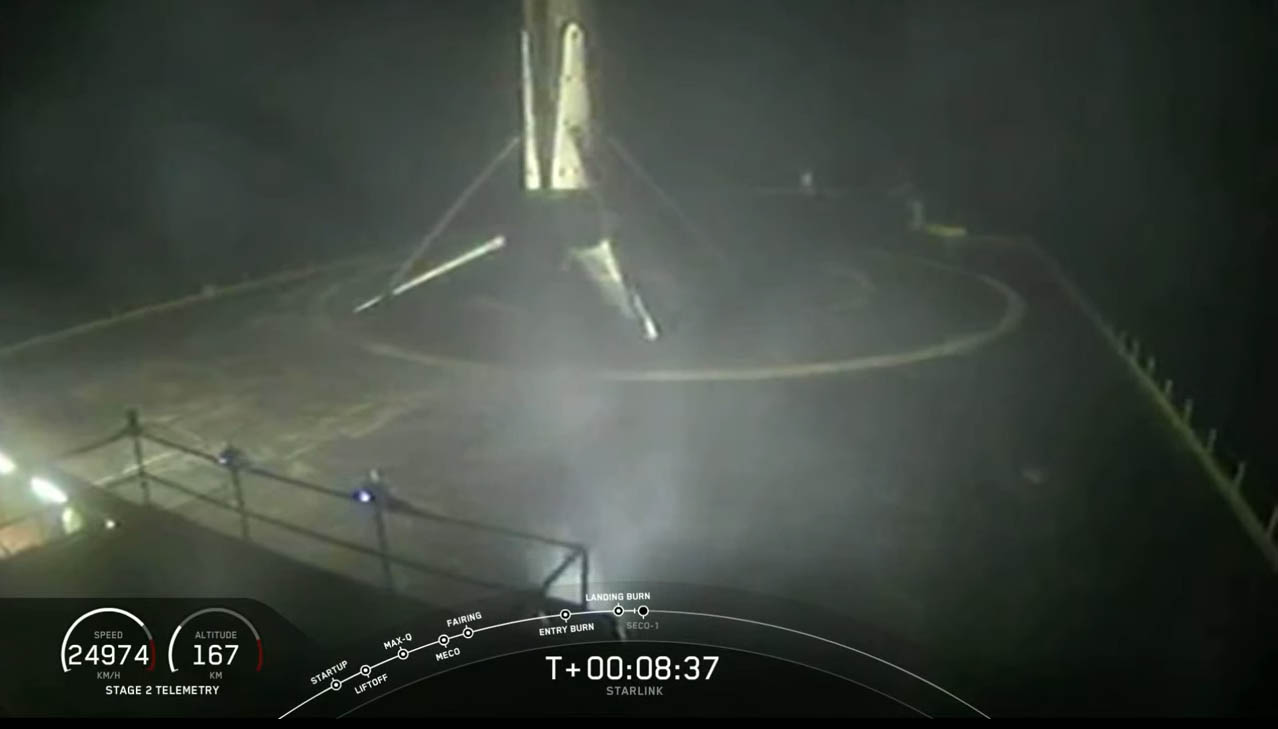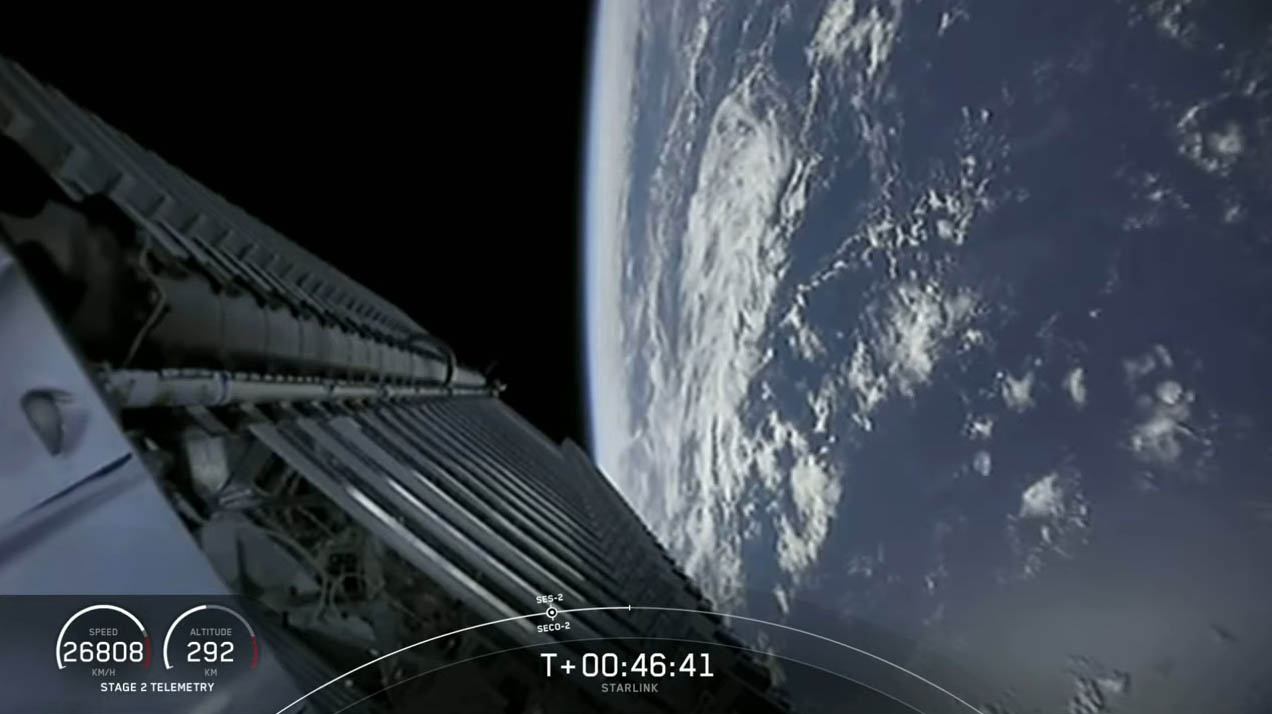SpaceX Launches 60 Starlink Satellites, Nails Rocket Landing in Record-Breaking Flight
SpaceX now operates more satellites than any other company. Thousands more will follow.
CAPE CANAVERAL, Fla. — SpaceX kicked off 2020 with the record-breaking launch of its third batch of Starlink satellites. Sixty of the internet-beaming satellites launched atop a used Falcon 9 booster on Monday, Jan. 6.
The sooty Falcon 9 rocket roared to life at 9:19 p.m. EST (0219 GMT Tuesday), lifting off from Space Launch Complex 40 at Cape Canaveral Air Force Station here in Florida. Its nine Merlin 1D engines lit up the night sky above the space coast as it climbed towards orbit.
"Liftoff! Go, Starlink, go, Falcon [on the] Space Force inaugural launch," a SpaceX launch commentator said. The mission was the first launch under the watch of the newly minted U.S. Space Force, a military branch that President Donald Trump signed into law last month.
The satellites rode into space atop a reused Falcon 9 first stage, marking the second time the company has flown a booster four times. The star of this mission, dubbed B1049.4 by SpaceX, previously lofted the first batch of Starlink satellites as well as the Iridium-8 and Telstar 18 VANTAGE missions.
Related: How to See the Starlink-2 Satellites in the Night Sky
Video: Watch SpaceX's Starlink-2 Falcon 9 Rocket Landing!

SpaceX successfully launched 60 new Starlink broadband internet satellites into orbit on a Falcon 9 rocket from Cape Canaveral Air Force Station, Florida on Jan. 6, 2020. The launch made SpaceX the operator of the largest satellite fleet in space today.

The Starlink-2 mission is actually the third Starlink launch for SpaceX, following launches in May 2019 and November 2019. Starlink-2 carried 60 more satellites into orbit for the constellation for a total of 180 Starlink satellites.

Here, SpaceX's Falcon 9 rocket first stage (left) can be seen deploying its grid fins to help its return to Earth. The lights of the U.S. East Coast can be seen in the background. At right, the second stage of the Falcon 9 powers toward orbit.

About 8.5 minutes after launch, the first stage of SpaceX's Falcon 9 returned to Earth for a successful landing on the drone ship Of Course I Still Love You stationed 339 miles off the U.S. East Coast in the Atlantic Ocean. This was the fourth flight (and landing) for the reusable booster.

The 60 Starlink satellites of SpaceX's Starlink-2 mission are seen still stacked together on the Falcon 9 second stage after reaching a coasting orbit. In a test, SpaceX coated one of the satellites in a darker material to reduce its albedo, or reflectivity. Astronomers have complained at how bright Starlink satellites are in space.
Following the successful launch, the rocket's first stage gently touched down on a SpaceX's drone ship landing platform "Of Course I Still Love You" in the Atlantic Ocean, marking the company's 48th booster recovery.
SpaceX designed its souped up Falcon 9 rocket to fly as many as 10 times with only light refurbishments in between. The company has yet to fly a booster five times, but with four successful flights under this booster's belt, it's likely that it could fly again in the future.
Breaking space news, the latest updates on rocket launches, skywatching events and more!
Building a constellation
The launch is part of the private spaceflight company's plan to create a constellation of small broadband satellites, each weighing slightly more than 485 lbs. (220 kilograms), that will provide internet coverage to the world below. With this launch, it brings SpaceX's burgeoning constellation up to 180 satellites, making it the largest satellite fleet in orbit.
SpaceX is not the one aerospace company with plans of connecting the globe. OneWeb launched its first set of six satellites in 2019, but SpaceX (with its own rockets) has quickly amassed a sizable constellation.
Elon Musk, SpaceX CEO and founder, has said the company will need at least 400 satellites in orbit to provide minimal coverage, and at least 800 to provide moderate coverage. That coverage could begin sometime this year, with it rolling out first in portions of the U.S. and Canada.
Related: SpaceX's 1st Starlink Megaconstellation Launch in Photos!
How it works
The goal of SpaceX's Starlink project is to provide constant high-speed internet access to users around the world. Currently, we rely on wireless cell towers or cables routed into our homes and offices to access the internet. As a result, rural and remote areas are often left without access. SpaceX wants to change that.
Traditional satellite internet providers beam internet coverage down from their satellites perched high above the Earth, in what's known as geostationary orbit (typically 22,000 miles, or 35,000 kilometers up). The signal has to travel such a long distance, which results in slow connections speeds.
By operating at a lower altitude SpaceX hopes to cut down on this issue and provide reliable coverage at an affordable price.
Preserving dark skies
Not everyone is thrilled about the idea of SpaceX's new mega-constellation. Astronomers have voiced concerns that the satellites could interfere with crucial scientific observations.
SpaceX's Starlink satellites stand out against the night sky. Almost immediately following the first launch, skywatchers noted that the tiny satellites are incredibly bright — even more so than the average satellite. That observation made scientists nervous about how the Starlink constellation could interfere with their work.
Astronomers rely on ground-based telescopes to take long-exposure images of astronomical objects they want to study. When something bright passed in front of the telescope's field of view, it can obscure the image.
Following the complaints, Musk and SpaceX said they would look into reducing the brightness of the satellites. To that end, the company says one of the satellites launching tonight will be unique. One side of it will be coated in a special material that will make it appear darker in orbit.
If this test goes well, future versions of the satellites could be coated in the same material.
Fairing recovery
One of SpaceX's fairing catcher boats, GO Ms. Tree, attempted to catch a fairing half in its giant outstretched net Monday night, but failed to snag it, SpaceX officials said.
"We didn't catch it this time. We got really close," SpaceX Starlink satellite engineer Laurel Lyons said during live commentary. "But we're going to keep on trying again."
Payload fairings (also known as the rocket's nose cone) are designed to protect the payload during launch. Each fairing is equipped with its own navigation system that allows it to glide gently back to Earth. The Falcon 9’s payload fairing come in two halves that are jettisoned once the rocket reaches space.
With each piece fetching roughly $3 million, SpaceX hopes to save some money by reusing them on future flights. To date, GO Ms. Tree (the vessel formerly known as Mr. Steven) has made two successful catches.
The company acquired a second vessel in order to eventually scoop up both fairing pieces. That ship, dubbed GO Ms. Chief, is sidelined tonight as crews work on necessary repairs due to damage sustained from its last mission.
- 'Whoa, It Worked': Elon Musk Tweets Via SpaceX's Starlink Satellites
- Space Companies Are Investing Big in 5G Technology
- See the Evolution of SpaceX's Rockets in Pictures
Follow Amy Thompson on Twitter @astrogingersnap. Follow us on Twitter @Spacedotcom or Facebook.


Amy Thompson is a Florida-based space and science journalist, who joined Space.com as a contributing writer in 2015. She's passionate about all things space and is a huge science and science-fiction geek. Star Wars is her favorite fandom, with that sassy little droid, R2D2 being her favorite. She studied science at the University of Florida, earning a degree in microbiology. Her work has also been published in Newsweek, VICE, Smithsonian, and many more. Now she chases rockets, writing about launches, commercial space, space station science, and everything in between.
